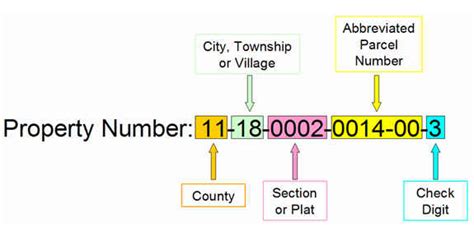How to Read a Parcel Number and Access Important Property Information
Finding information about a property can feel like navigating a maze, but understanding parcel numbers is your key to unlocking a wealth of data. This guide explains how to decipher these seemingly random numbers and use them to access crucial property details. We'll cover everything from understanding the format to utilizing online resources and even touch upon the potential pitfalls to avoid.
What is a Parcel Number?
A parcel number, also known as a property identification number or PIN, is a unique identifier assigned to each individual piece of land within a county or municipality. Think of it as a property's social security number – it's its unique identifier used for official records and tracking. These numbers are typically alphanumeric (containing both letters and numbers) and are structured differently depending on the region.
How to Read a Parcel Number
There's no single universal format for parcel numbers. The structure varies significantly from one county to another, even within the same state. However, they generally follow a logical system designed to provide information about the property's location. Some common elements might include:
- County Code: Indicates the county where the property is located.
- Township and Range: Refers to a geographical grid system used for land surveying.
- Section, Block, and Lot: Further subdivisions within a township and range, narrowing down the precise location of the parcel.
Example: A parcel number like "12-34-56-789" might indicate County 12, Township 34, Range 56, and Lot 789. However, this is just an illustration; the actual meaning of each part depends entirely on the specific county's numbering system.
Where to Find a Parcel Number
Locating a parcel number is usually straightforward. You can find it on:
- Property Tax Statements: This is often the easiest place to find it.
- County Assessor's Website: Most counties have online databases with searchable property records.
- Deed or Title: Your property deed will clearly state the parcel number.
- Real Estate Listings: Real estate websites often include the parcel number in property descriptions.
- County GIS (Geographic Information System) Maps: These maps are interactive and allow you to locate parcels visually.
Accessing Property Information Using the Parcel Number
Once you have the parcel number, you can use it to access a trove of information, including:
- Property Address: Confirm or find the official address associated with the property.
- Owner Information: Find the current owner's name and contact details.
- Property Taxes: Access details about assessed value, tax rates, and payment history.
- Property Size and Boundaries: View the lot size and its precise boundaries.
- Improvements: Learn about any structures on the property (houses, sheds, etc.)
- Zoning Information: Determine the permitted uses for the property.
- Sale History: Review past sales transactions and prices.
- Legal Descriptions: Access formal legal descriptions of the property.
Most county assessor websites and GIS systems provide online access to this data. Simply enter the parcel number into the search bar, and you'll gain access to the property's record.
What Information Can't I Access With a Parcel Number?
While parcel numbers provide extensive information, there are limitations:
- Private Owner Information: Some sensitive owner details might be redacted for privacy reasons.
- Interior Details: You won't typically find information about the interior of the property (decor, appliances, etc.).
- Highly Confidential Data: Information like mortgage details is usually not publicly accessible.
How to Find a Parcel Number Without an Address
If you know the general location but not the exact address, you can often find the parcel number using the county GIS mapping system. Zoom into the area on the map, and many systems allow you to click on individual parcels to reveal their corresponding numbers.
What if I Can't Find the Parcel Number?
If you're having trouble locating the parcel number, contact your local county assessor's office directly. They can assist you in finding the correct number using other identifying information, such as the property address or a legal description.
By understanding how to read and utilize parcel numbers, you'll greatly simplify your research into property information. This empowers you to make informed decisions, whether you're buying, selling, or simply curious about a specific property. Remember that the specifics of parcel numbers and accessible data will always vary by location; contact your local county assessor's office for assistance if needed.

